Related Research Articles
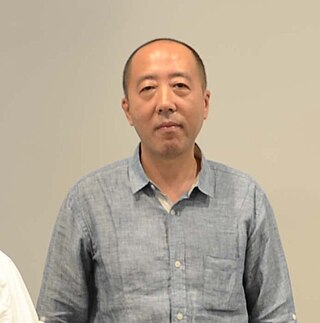
Zhang Dali is an artist based in Beijing.
Sui Jianguo,professor and ex-chairman of the Department of Sculpture in Central Academy of Fine Arts in Beijing,is a contemporary Chinese artist.
Qiu Zhijie is a contemporary Chinese artist who works primarily in video and photography. Overall,Qiu's work suggests the struggle between the forces of destiny and self-assertion. Other common themes are social fragmentation and transience.
Gu Wenda is a contemporary artist from China who lives and works in New York City. Much of his works are themed around traditional Chinese calligraphy and poetry. His works also often use human hair.

Li Songsong is a Chinese artist working in Beijing.
Zheng Guogu is an artist based in Yangjiang in the Guangdong province of China,one of three artists in the artist collective known as Yangjiang Group. In 1992,he graduated from the printmaking department of the Guangzhou Academy of Fine Arts.
Shang Yang is a contemporary Chinese painter based in Beijing and is considered one of the most important painters of the life-stream movement. Known for his oriental humanist thought he believes landscapes are living things and puts their spirit into his brushwork. In 1965 he graduated from the Hubei Art Academy,where he then taught for several years. He received his masters from the Hubei Art Academy in 1981. Yang became the Associate President in 1989. Shang Yang became a Professor and the Officer-in-Charge of Fine Arts at the Research Institute of South China Normal University in 1993. Also in 1993,he became the Vice President of the Chinese Art painting Society. Shang Yang has exhibited extensively in China since the 1980s,including at Shanghai Biennale in 1996,and has shown internationally at galleries in London,Paris,Tokyo,St. Petersburg,and Helsinki. Shang Yang's work often appropriates images from traditional Chinese landscape painting,which are screened onto the canvas by a machine;he then distorts the image with graffiti or obtrusive geometrical designs. His works combine avant-garde exploration and solid artistic skill to create unique works of expressionism oil painting.
Ma Liuming 马六明 is a contemporary Chinese painter active in performance art. He is known most of all for his exploration of the power and poetry of public nudity in China,where such behavior was strictly forbidden. That is why he has been the target of government censorship,unable to perform in his own country for most of his career.
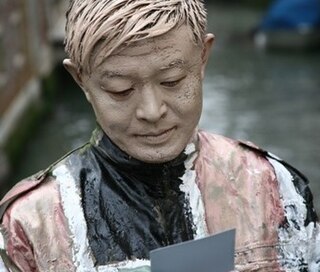
Liu Bolin is a contemporary concealment artist born in China's Shandong province. He earned his Bachelor of Fine Arts from the Shandong College of Arts in 1995 and his Master of Fine Arts from the Central Academy of Fine Arts in Beijing in 2001. His work has been exhibited in museums around the world. Also known as "the invisible man",Liu's most popular works are from his "Hiding in the City" series,photographic works that began as performance art in 2005 in response to the artists' village in which he worked in Beijing being demolished in preparation for the 2008 Beijing Olympics.
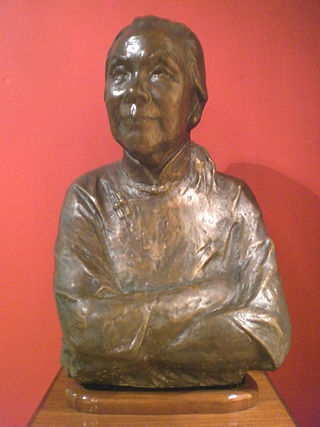
Fang Zhaoling,also known as Lydia Fong,was a Chinese painter and calligrapher.
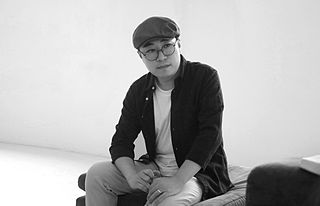
Yang Yongliang is a Chinese contemporary artist.

Kwok Mang Ho,also known as Frog King,is a multi-media,conceptual,visual and performance artist from Hong Kong. According to Oscar Ho,the former exhibition director of Hong Kong Art Centre,he is one of the pioneers of contemporary art in Hong Kong during the early 70s. His artistic uniqueness is best expressed in his creations “Frogtopia”,which takes over the exhibition space with numerous colourful mixed-media installations and graffiti of his signatured frog icon. In addition to his inexhaustible style,Kwok held a solo multimedia art exhibition representing Hong Kong “Frogtopia-Hongkorucopia” (蛙托邦•鴻港浩搞筆鴉) at the 54th Venice Biennale in 2011. He is currently the director of the Frog King Museum at Cattle Depot Artist Village since 2001.
Jennifer Wen Ma is a visual artist working and living in New York and Beijing. Ma's interdisciplinary practice bridges varied media such as installation,drawing,video,public art,design,performance,and theatre;often bringing together unlikely elements to create sensitive,poetic,and poignant works.
Chen Ke is a Chinese artist. She currently lives and works in Beijing. Having participated in numerous international and domestic exhibitions,Chen Ke has worked in a variety of media,including painting,sculpture and fashion design. Chen Ke is recognized as the most representative artist of the New Generation of Cartoon of China.
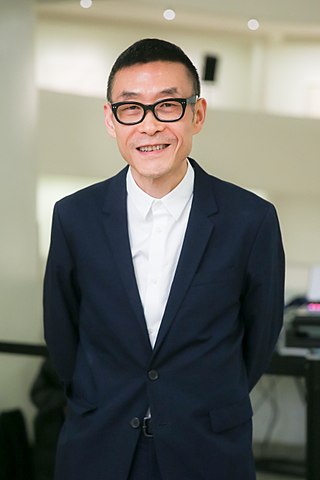
Wang Jianwei is a new media,performance,and installation artist based in Beijing,China.
Yang Jiechang is a contemporary artist of Chinese origin. He is known for his proficiency in traditional Chinese media.
Li Xinmo is a Chinese feminist artist,art critic,and teacher. She graduated from the Department of Chinese Painting,and received her master's degree from Tianjin Academy of Fine Arts in 2008 and now resides in Beijing. She is a member of the German IO culture institution,vice president of Chinese and Germany culture communication organization. Li is mainly devoted to feminist theory and contemporary art criticism research. Her creation involves a series of issues such as gender,ethnicity,environment,and national politics. Her artworks are based on a variety of media,especially performance,photography and painting. Her works have been exhibited in major art galleries such as the Louvre in France,the National Museums of World Culture in Gothenburg,Sweden,and the Bonn Women's Museum in Germany. She also participated in Toronto Photo Biennial and Prague Art Biennial. Many museums such as the Taida Museum and the Museum of Far Eastern Antiquities in Sweden have some of her works.

Xing Danwen is a contemporary Chinese artist and photographer. She is known for the images she made during and after her MFA at the School of Visual Arts in New York,exploring ideas of dislocation as well as the form and psyche of contemporary living.

Wang Huangsheng is a Chinese-born curator,educator and artist who is currently residing in Beijing. He used to serve as the director of China Central Academy of Fine Arts Museum for eight years. As an curator,he is most known for his curated events. He has been the curator of Guangdong Museum of Art and the Museum Art of Central Academy of Fine Arts for a long time.
Hu Zhiying is a contemporary Chinese avant-garde artist and art educator. He works within the areas of painting,installation,video art,and conceptual art. His artworks are displayed worldwide,and he has taught painting and calligraphy at the Guangzhou Academy of Fine Arts and South China Normal University.
References
- ↑ "Zheng Lianjie". New York Times . 2002. Archived from the original on 2017-04-26.
- ↑ "Zhenglianjie". Cha: An Asian Literary Journal . 2011. Archived from the original on 2012-04-01.
- ↑ "Beijing Earth Calligraphy and Painting Art School". Hudong.com . 2011. Archived from the original on 2022-08-08.
- ↑ "Reappearing Exit IV: Performance Art of Zheng Lianjie". [By Robert LEE]. 2002.
- ↑ "ArtAsiamerica". Archived from the original on 2012-09-04. Retrieved 2012-04-29.
- ↑ "Zhenglianjie got the title of United Nations Messenger of Peace". [By XINHUANEWS]. 2012. Archived from the original on October 22, 2014.
- ↑ "Art in Review – Zheng Lianjie". New York Times . 2002. Archived from the original on 2017-04-26.
- ↑ "Subzero New York Zheng Lianjie". [GG-Art.com]. 1998. Archived from the original on 2016-03-04.
- ↑ "Performance Art at Tian'anmen" (PDF). [By Minna Valjakka]. 2000. Archived (PDF) from the original on 2016-03-04.